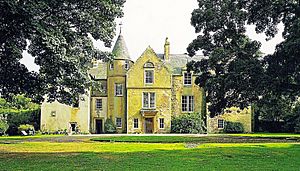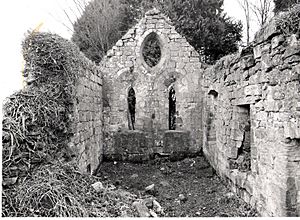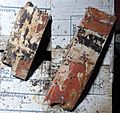Keith Marischal facts for kids
Quick facts for kids Keith Marischal |
|
|---|---|

Northern facade and entrance of Keith Marischal House
|
|
| Location | Humbie, East Lothian |
|
Listed Building – Category B
|
|
| Official name: Keith Marischal House | |
| Designated | 5 February 1971 |
| Reference no. | LB7752 |
| Official name: Keith Kirk | |
| Designated | 20 June 1936 |
| Reference no. | SM758 |
| Lua error in Module:Location_map at line 420: attempt to index field 'wikibase' (a nil value). | |
Keith Marischal is a large country house in Humbie, East Lothian, Scotland. It is built in the Scottish Baronial style, which means it looks like an old Scottish castle. The first part of the house was an "L-shaped" Tower house built before 1589. Later, it was made bigger into a "U-shaped" building with a courtyard. In the 1800s, the courtyard was filled in, giving the house its look today. Keith Marischal House is a protected building, known as a category B listed building.
Contents
The Story of Keith Marischal
Ancient Legends and Early Owners
Long ago, the lands of Keith were given to a brave warrior named Marbhachir Chamuis, also called Camus Slayer. This was to thank him for his courage at the Battle of Barry in 1010. He is thought to be the first ancestor of the Clan Keith family.
Later, in the time of King David I, a man named Simon Fraser of Keith owned these lands. He was one of the Normans who came to Scotland with King David. Simon Fraser was an important person, and he helped build a church for monks at Kelso Abbey.
It is not clear how the lands of Keith then went to another Norman, Hervey de Keith. He was the King's Marischal, a high-ranking officer. Hervey owned the lands of Keith when he built a church there in the late 1100s. His family later took their name from this estate, becoming the "Keith" family.
Keith Lands and the Marischal Title
The area around Humbie was once divided into "Keith Harvey" and "Keith Hundeby". These were the main parts of the Keith family's lands. The Keith family became very powerful. In 1176, Hervey's descendants were made the official hereditary Marischal of Scotland. This meant the title would pass down through their family. They later received the rock of Dunnottar Castle in Aberdeenshire at the end of the 1300s.
Changes Through the Centuries
16th Century Events
Keith Marischal House was mentioned in 1489 in a disagreement between the Earl Marischal and William Hog. The house also saw conflict during a war called the Rough Wooing in 1550. English raiders burned some buildings at "Nether Keith" and in the nearby village. William Keith, 4th Earl Marischal stayed at Keith Marischal around 1554 or 1555.
Building the House
The main part of the house, an L-shaped tower, was built before 1589 by George Keith, 5th Earl Marischal. It was built on top of older structures. Around the house, there are signs of an old wall called a Barmkin and earthworks. These show that a very old settlement or castle once stood here.
George, 5th Earl Marischal, represented King James VI at his wedding to Anne of Denmark in 1589. It is said that the wooden beams in the tower's roof came from timber given to him by the Danish King Christian IV of Denmark. Inside the house, there are also pieces of a beautiful painted ceiling from that time.
Witchcraft Stories
The North Berwick Witch Trials
In 1589, King James went to Norway to bring his new wife, Anne, back to Scotland. On their way home, a big storm hit their ships. King James was very superstitious and believed the storm was caused by witchcraft. This led to the famous North Berwick Witch trials.
One of the main people accused was Agnes Sampson, known as the "Wise Wife of Keith" because she lived near Keith Marischal. She was accused of being a witch.
Later Witch Trials
Later, in 1678, one of the last witch trials in Scotland happened in Humbie. The people accused were held in the Chapel at Keith Marischal the night before they were executed. Their execution took place at a spot called Dow Syke, about a mile north of the house.
From the 18th Century to Today
New Owners and Changes
In the late 1600s, Keith Marischal was sold to the Earls of Hopetoun. The Keith family lost their properties because they supported the Jacobites during the Glorious Revolution. The Hope family bought many properties from Jacobite supporters. They made big changes to Keith Marischal. They added a new wing to the west side of the house, creating a courtyard. The original tower became the east wing. A beautiful walled garden was added in 1807.
Modern Appearance
Before 1889, the house was sold to the family of Patrick Fraser Tytler. They hired architects to fill in the courtyard. This added new corridors, so people did not have to walk through one room to get to another. At this time, the outside of the house was also given a more "baronial" look. Fake turrets and crawstep gables were added to match the older parts.
In 1953, the architect Sir Robert Hogg Matthew bought the property. Today, the Rogers family owns Keith Marischal House.
Other Buildings at Keith Marischal
The Ruined Chapel
In the grounds of Keith Marischal House, there is a ruined chapel. It is a scheduled ancient monument, which means it is a very important historical site. The chapel is in an early Norman Gothic style. This is likely the church that Hervey de Keith built long ago.
In the 1800s, the chapel was partly restored. It has interesting details, like a monument from the 1600s to the Anderson family. There are also spiral carvings on the outside of a window and an old tombstone of a crusading knight. Some believe this might be a memorial to Sir William Keith. He was a companion of Sir James Douglas who tried to take the heart of Robert the Bruce to the Holy Land.
In 1618, the parish of Keith Marischal joined with Humbie. The chapel at Keith Marischal was no longer used as a main parish church. It might have become a private chapel for the Keith family.
Images for kids
-
Fragments of painted pine boards from a ceiling at Keith Marischal House






